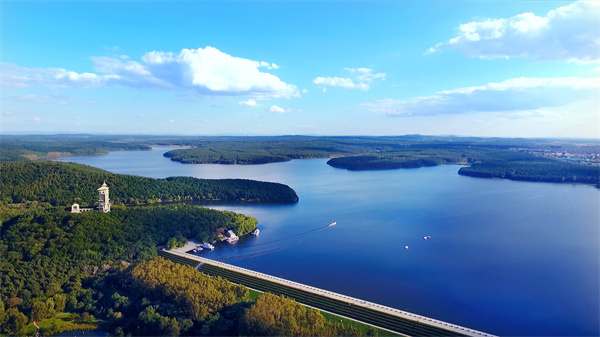
Changchun in Ancient Times
It is a piece of fertile land where humans came to live 40,000 years ago.
In 1951, mammal fossils and corresponding relics were unearthed in Yushu, Changchun city, testifying that hominids here were in the late Old Stone Age (Paleolithic Era), or in the early stage of a matriarchal society.
In 1984, a site of human settlement in early New Stone Age was found in Nong'an county, Changchun. Excavations proved that they had entered the era of wearing clothes and mastered developed primitive farming and weaving technologies.
The earliest city that appeared in this region was called "Fuyu Realm". From Eastern Han Dynasty (25-220) to Western Jin Dynasty (265-316), the nation of Fuyu ethnic group was subordinate to Central Plain.
In 493, Fuyu Realm was toppled by the northern ethnic group Wuji. In 494, the king and his wife were sent into exile in Goguryeo, marking an end to the realm of Fuyu.
In the first year of Emperor Xuanzong's reign of Tang Dynasty (618-907), Bohai Realm emerged, with the current territory of Changchun covered in it.
In the Northern Song Dynasty, Huanglongfu (now Nong'an county) was founded after the establishment of Liao Realm.
The region enjoyed great prosperity in the Liao and Jin dynasties. In 1234, the Mongols finished off the Jin Dynasty (1115-1234), and renamed the reign Yuan, making it a nomadic place for the Mongols.
In 1644, rulers of the Qing Dynasty (1644-1911) put the Mongols and Manchurians living in the region into the system of Eight Banners. Since then, the region was declared a protected area.
War of Liberation
Changchun's name implies the meaning of blessing and auspiciousness. However, the city has witnessed a painful part of the history in modern China. From 1931 to 1945, Japan occupied Changchun and established Manchukuo to govern northeastern China. Most of the Japanese-style architecture has been preserved and opened to the public.
On August 8, 1945, the Soviet Union declared war on Japan. Japan surrendered unconditionally on August 15, 1945. On August 18, the emperor of Manchukuo announced abdication. On September 20, the Red Army of the Soviet Union marched into Changchun and established the garrison command headquarters.
All Manchukuo ministers, together with their emperor Puyi, which was also the last emperor of China as the eleventh and final Qing dynasty ruler, were arrested and taken to the Soviet Union, which marked the end of the 14-year puppet regime established by the Japanese imperialists.
Modern Changchun
Changchun has experienced three stages of development since its peaceful liberation on October 19, 1948.
I. Transformation to a Production-oriented City
Changchun was the center of Japanese colonial rule in Northeast China. It had businesses, restaurants, hotels and as well as various "clubhouses" purposefully built for officials of the puppet regime Manchukuo. In addition to construction contractors and building material makers, the city produced publications, matches, flower products, oil, liquor, food, tobacco as well. It could be defined as a typical consumption-oriented city.
After 1948, the CPC Changchun Municipal Committee and the People's Government of Changchun City decided to transform the city from a consumption-oriented city to a production-oriented one.
Four years of hard work restored the city's economy and brought it to a new stage of development. The output value of state-operated enterprises increased by 4.3 times in 1952 from 1949's record; that of collective-owned enterprises increased by 20 times; and that of private enterprises went up by 2.6 times.
The city's economic structure changed as the national economy grew stronger after it getting back on track, thereby forming a socialist economic system that was pillared by stated-operated economy, supported by collective economy and supplemented by private economy. The rapid development of state-operated economy laid a solid foundation for the transformation to a production-oriented city.
In the China's First Five-Year Plan (1953-57) period, the First Automobile Works (FAW) went operational, followed by a list of other state-operated enterprises. Driven by the central enterprises, local enterprises developed rapidly, facilitating the transformation to a production-oriented city from a consumption-oriented one.
II. Transformation to an Open City
After twists and turns in the early stage of its development, Changchun started transforming to an open city. However, things changed when the Second Five-Year Plan (1956-1961) was implemented.
Changchun, in the wake of the economic upheavals of the Great Leap Forward social restructuring campaign and the "cultural revolution" (1966-76), broke the closed-off management system and established a city management mode with Changchun as the center, counties as links and rural areas as the foundation, and embraced market-oriented reforms.
This increased the city's influence and attractiveness and meanwhile made it more open, thereby becoming to an open city.
III. Transformation to a Modern International City
In line with the decision made by the CPC Changchun Municipal Committee after summarizing the evolutionary experience of the city, efforts have been put into building Changchun into a modern international city within about 30 years.
The government decided to take three steps, namely, the foundation-laying stage from 1993 to 2000, the development stage from 2001 to 2015, and the improvement stage from 2015 to 2020, to achieve the strategic goal of making Changchun an important city in Asia-Pacific economic rim and even in the world economy that enjoys highly developed market economy, highly advanced social civilization, complete infrastructure, high-level management and high-quality ecological environment.







